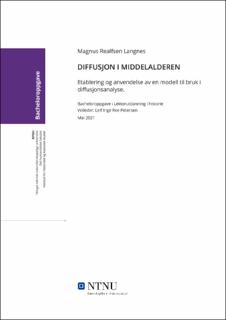| dc.contributor.advisor | Petersen, Leif Inge Ree | |
| dc.contributor.author | Langnes, Magnus Realfsen | |
| dc.date.accessioned | 2021-09-13T16:09:09Z | |
| dc.date.available | 2021-09-13T16:09:09Z | |
| dc.date.issued | 2021 | |
| dc.identifier | no.ntnu:inspera:80117600:37447342 | |
| dc.identifier.uri | https://hdl.handle.net/11250/2775749 | |
| dc.description.abstract | Målet med oppgaven er å etablere en modell som skal kunne bli brukt i diffusjonsanalyse. Modellen skal bygge videre på den tradisjonelle måten å analysere diffusjon, som er på bakgrunn av filologi og empiri, for å så heller se dypere på samfunnsbaserte utgangspunkter for diffusjon. Disse utgangspunktene blir det som danner modellen og baserer seg på moderne konsum og diffusjonsteori. Videre bruker oppgaven den islamske gullalder som utgangspunkt i å finne historiske eksempler som kan kobles opp mot modellen. Modellen blir først brukt til å se på diffusjonen av trekkraftskatapulten, der det er en rekke områder modellen blir anvendt for å bedømme sannsynligheten til ulike alternativer for diffusjonsvei. Det viktigste spørsmålet oppgaven tar for seg er avarernes rolle i diffusjonen av trekkraftskatapulten, der bruken av modellen resulterer i konflikt med en tradisjonell forståelse og velger heller da en alternativ vei. Den andre teknologien som blir analysert er qanatsystemer, der modellen blir brukt som pekepinn på hvilke samfunnsmessige elementer som kan være viktige å se nært på i diffusjonsanalyse. Til slutt blir modellens verdi opp mot analysene diskutert. | |
| dc.description.abstract | The goal of the thesis is to establish a model to be used in diffusion analysis. The model is going to take the traditional way of analyzing diffusion with philological and empirical proof as the foundation and expand upon them with a deeper perspective, taking a look at the societal level of the diffusion. The model consists of several societal demands that should be filled if diffusion is to happen successfully. these demands are based on modern diffusion theory and domestication theory as the baseline. The thesis goes on and uses the Islamic golden age as a historical example of a society that evolved to fulfill and contain the demands from the model. The model is first applied by discussing the diffusion of the traction trebuchet. This diffusion contains several points of conflict, where the model is successfully applied to measure the probability of where the diffusion happened. The most interesting part of this section comes from debating the role the Avars had in diffusing the traction trebuchet. This is the major point the thesis differs from a more traditional and established view, by selecting an alternate path as more probable. The thesis continues by discussing the diffusion of qanats. This analysis is somewhat different than the previous one, with the demands from the model used as pointers to show what societal dynamics should be looked closely at when analyzing diffusion. The conclusion of the thesis looks back at the model and its value in context of the thesis and diffusion analysis as a whole. | |
| dc.language | nob | |
| dc.publisher | NTNU | |
| dc.title | Diffusjon i Middelalderen - Etablering og anvendelse av en modell til bruk i
diffusjonsanalyse | |
| dc.type | Bachelor thesis | |
